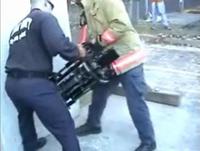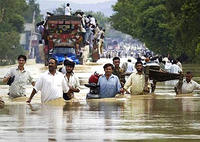-
Louisiana parish plans extreme weather alert system
Emergency officials in Ouachita Parish, Louisiana are considering installing warning sirens that would alert residents of dangerous weather; officials hope to install sixty towers throughout the Parish; authorities are currently conducting feasibility studies to determine if installing the sirens is practical and a financial possibility
-
-
Roving robot can rescue people, detonate bombs
Northeastern University student-researchers have created a roving robot that can locate and rescue victims of natural disasters or participate in military missions that are too dangerous for soldiers; students created a complex algorithm that would enable the robot to locate people — or even bombs that are detonated through mobile phones
-
-
Key to coping with disasters: neighbors
A political scientist who had moved to New Orleans only weeks before Hurricane Katrina concluded that neighbors — and cooperation among neighbors — are more important for surviving, coping with, and recovering from disasters than ambulances and fire trucks and government aid; to make sure his observations were more than anecdotal, he visited disaster areas around the world, and his data show that his personal experiences reflect a larger truth
-
-
FAA studies general aviation airports

There are 368 primary airports in the United States — and 2,950 nonprimary, or general aviation, airports; the FAA is now studying the roles and functions of these general aviation airports; general aviation airports provide a variety of functions, ranging from access for emergency medical services, disaster relief, aerial firefighting, law enforcement, and border control to agricultural functions, flight training, charter passenger and time-sensitive air cargo services, among others
-
-
Concrete-breaching rescue tool available via GSA schedule

Raytheon’s Controlled Impact Rescue Tool (CIRT) is a portable unit designed to aid fire departments, local and federal rescue agencies, and the military services; the tool sends pulverizing shock waves that enable rescuers to breach concrete structures faster than with existing techniques such as drilling, chipping or sawing; GSA has just added CIRT to the GSA schedule
-
-
Oh my, the trouble with evacuating lions, tigers, and bears

Rescuing and housing the many exotic animals at Minot, North Dakota’s Roosevelt Park Zoo from record floods presented zoo workers with a unique challenge; it was no small feat finding vehicles large enough for giraffes or getting dangerous animals like bears and wolves to cooperate; currently more than 100 animals are housed in an old furniture warehouse; makeshift pens hold deer, emu, warthogs, bobcats, monkeys and chickens, while workers struggle to keep the animals comfortable
-
-
Pinellas County, Florida simulates anthrax attack
Last Wednesday a local health department in Florida staged an elaborate disaster exercise replete with angry mobs, fainting citizens, and shouting matches; the exercise, dubbed Operation MedStock, gave officials from the Pinellas County Health Department an opportunity to respond to a simulated anthrax attack
-
-
Hattiesburg, Mississippi receives $13,000 DHS grant
Hattiesburg, Mississippi recently received a DHS grant for $13,789 to purchase search and rescue equipment; the grant was awarded by the Mississippi Office of Homeland Security and comes as part of a $200 million DHS grant program designed to bolster emergency management and preparedness capabilities at the state, local, and community level
-
-
New smartphone app reduces information overload
Researchers have developed a new smartphone application to avoid information overload by processing large quantities of data in real time and presenting it in user friendly clusters; the software is the first to allow a user to make real time adjustments to how information is displayed on a phone as it is acutely “aware” of how cluttered the screen is; the new application can be used in a wide array of instances including natural disasters, monitoring multiple hospital patient’s heart levels, and mapping the locations of first responders deployed during an emergency
-
-
Massachusetts firefighters purchase chemical fire equipment
Local firefighters in Massachusetts recently received a new foam trailer capable of pumping out 500 gallons per minute; to control chemical fires and other difficult blazes, firefighters often use foam to coat the fuel to deprive the fire of oxygen; the new foam trailer is particularly useful as Ayer is home to several chemical and electrical facilities
-
-
Firefighters struggling with Arizona's second largest wildfire in history

Firefighters in eastern Arizona are struggling to contain the second largest wildfire in the state’s history; as the blaze burns toward New Mexico, Arizona officials have been forced to evacuate mountain resort communities and close national forests and parks; the wildfire has been burning steadily since 29 May; the conflagration now covers more than 311,000 acres in the White Mountains of eastern Arizona, and is threatening to damage power lines carrying electricity to Tucson; the fire is growing at a rate of four to five miles a day and protracted drought and dry, high winds have hampered efforts to control the blaze
-
-
Anytime, anywhere communications across all devices enhances collaboration

Connecticut-based company offers anytime, anywhere communications across all types of devices — allowing public safety, emergency response, and select critical infrastructure entities to communicate and collaborate in the event of an emergency; the system may also be used by the military — in the field thousands of miles away — to alert, and provide information to in real time, domestic emergency agencies
-
-
42 million displaced by natural disasters in 2010

In 2010 approximately forty-two million people were displaced from their homes due to natural disasters, more than double the number of people forced to relocate in 2009; the latest numbers were calculated by the Internal Displacement Monitoring Centre (IDMC), which found that more than 90 percent of disaster displacements were the result of weather-related events; the number of natural disasters has doubled from roughly 200 to over 400 a year during the last twenty years; the report found that countries on all continents were affected by the increase in natural disasters, but Asian countries have been hit the hardest
-
-
Connecticut addresses children's needs in disasters
Lawmakers in Connecticut recently passed legislation to help ensure the safety of children during a natural disaster or terrorist attack; on Tuesday, Connecticut’s House of Representatives approved a bill that would require the state to include the well-being of children in its emergency response plans; the bill passed 125 to 1 on Tuesday; under the law, the Commissioner of Emergency Management and Homeland Security is required to file annual reports that address the health needs of children during a biological attack or other incidents; the bill is currently on its way to Governor Dannel P. Malloy who is expected to sign it into law
-
-
Louisiana parish appoints new emergency preparedness chief
Ouachita Parish, Louisiana has ended their six-month search for a new director of Homeland Security and Emergency Preparedness just as hurricane season is about to hit; the parish’s Homeland Security Committee appointed Tracy Hilburn as the agency’s new director; the committee said that it was critical to have a new director in place before 1 June, the official start of the Atlantic Ocean’s hurricane season; as director of the parish’s Homeland Security and Emergency Preparedness agency, Hilburn will be responsible for coordinating evacuations for not only Ouachita, which is the largest parish with nearly 150,000 residents, but also the surrounding parishes
-
More headlines
The long view
Using Drone Swarms to Fight Forest Fires
Forest fires are becoming increasingly catastrophic across the world, accelerated by climate change. Researchers are using multiple swarms of drones to tackle natural disasters like forest fires.
